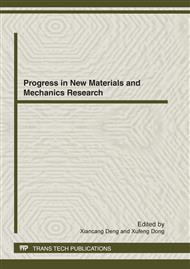[1]
H.J. Zhang, Y.X. Li, H.F. Zhang, Application of Near Infrared Spectroscopy in Wood Water Content Prediction, Advanced Materials Research. 187 (2011) 434-438.
DOI: 10.4028/www.scientific.net/amr.187.434
Google Scholar
[2]
H.J. Zhang, Y.X. Li, H.F. Zhang, Moisture Content Prediction of Korean Pine Wood Based on Near Infrared Spectroscopy at Varied Wave Lengths, Journal of Northeast Forestry University. 39 (2011) 83-85.
Google Scholar
[3]
Z.H. Jiang, A.M. Huang, Water in Wood and Its Near Infrared Spectroscopic Analysis, Spectroscopy and Spectral Analysis. 26 (2006) 1464-1468.
Google Scholar
[4]
L. R. Schimleck, R. Evans, J. Llic, and A. C. Matheson, Estimation of wood stiffness of increment cores by near infrared spectroscopy, Canadian journal of forest research. 32(2002) 129-135.
DOI: 10.1139/x01-176
Google Scholar
[5]
P. Li, H.F. Zhang, Y.X. Li, Use of BP Neural Network in Near-Infrared Spectroscopy calibrations for Predicting of Wood Density, Advanced Materials Research. 129-131 (2010) 306-311.
DOI: 10.4028/www.scientific.net/amr.129-131.306
Google Scholar
[6]
Y.X. Li, H.F. Zhang, Y.Z. Zhang, Modeling of Dahurian Larch Wood Density Based on NIR and Multivariate Analysis, Journal of Northeast Forestry University. 38 (2010) 27-30.
Google Scholar
[7]
J. Chen, X. Chen, W. Li, Study on Discrimination of Corn Seed Based on Near-Infrared Spectra and Artificial Neural Network Model, Spectroscopy and Spectral Analysis. 28 (2008) 1806-1809.
Google Scholar
[8]
Z. Zhou, J. Liu, X.Y. Li, Discrimination of Moldy Chinese Chestnut Based on Artificial Neural Network and Near Infrared Spectra, Transactions of the Chinese Society for Agricultural Machinery. 40 (2009) 109-112.
Google Scholar
[9]
X.Y. Zhao, Y. Guan, T.Y. Shang, Qualitative discrimination of bean oil by near-infrared transmission spectra and artificial neural network, Acta Agriculturae Zhejiangensis. 23 (2011) 825-828.
Google Scholar
[10]
S.F. Li, L.H. Zhang, X.H. Liu, Discriminant Analysis of Apple Moldy Core Using Near Infrared Diffuse Reflectance Spectroscopy Based on Principal Component Analysis, Transactions of the Chinese Society for Agricultural Machinery. 42 (2011).
Google Scholar
[11]
X.L. Li, Y. He, Z.J. Qiu, Application PCA-ANN Method to Fast Discrimination of Tea Varieties Using Visible/Near Infrared Spectroscopy, Spectroscopy and Spectral Analysis. 27 (2007) 279-282.
Google Scholar


